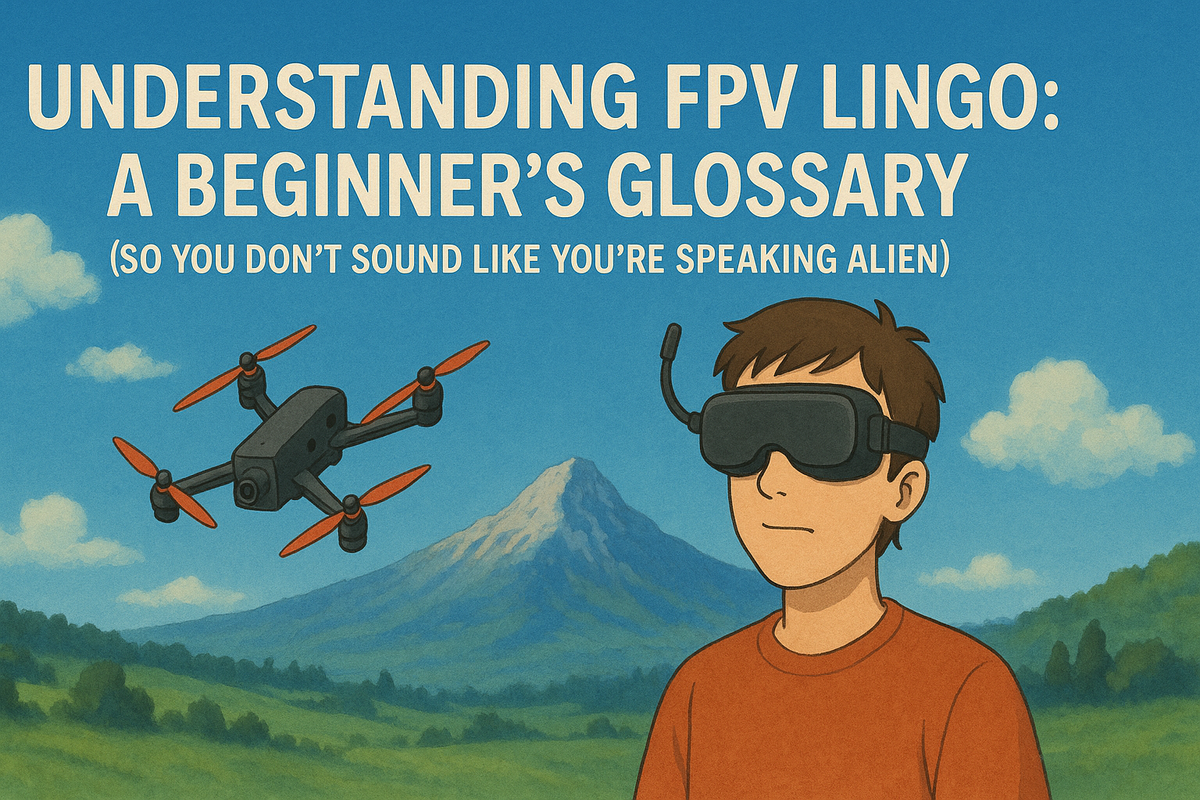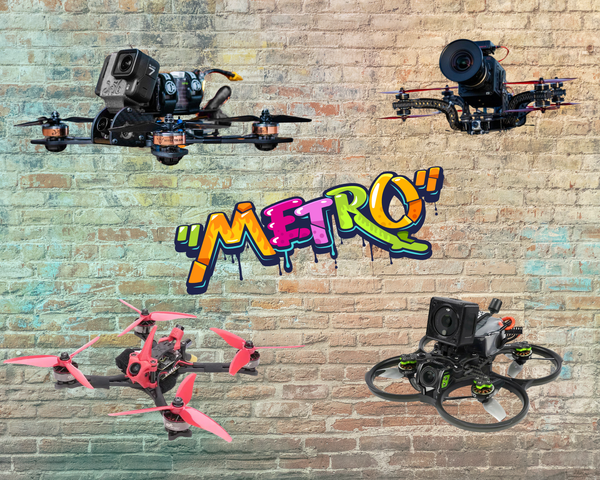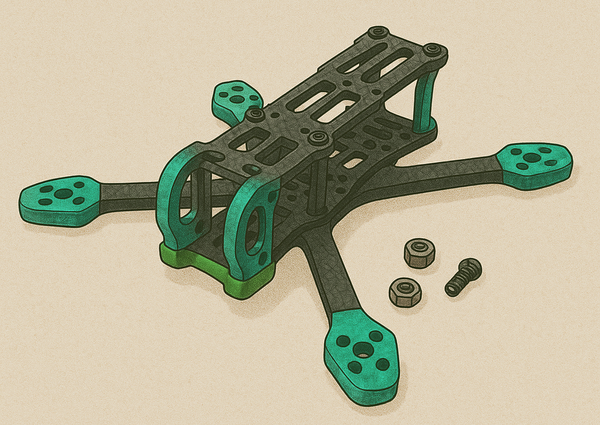Understanding FPV Lingo: A Beginner's Glossary


Welcome, aspiring FPV pilots! You've bravely decided to enter a world of exhilarating flight and breathtaking views. But first, we need to decode the secret language that seasoned pilots throw around like frisbees. Fear not! This expanded glossary will not only define the terms but also give you a better grasp of why they matter.
I. Core Components & Systems:
- FC (Flight Controller): Think of the FC as the central nervous system and brain of your drone. It houses sophisticated sensors like gyroscopes and accelerometers that detect the drone's orientation and movement. It constantly receives commands from your radio receiver and processes them along with the sensor data to precisely control the speed of each motor, ensuring stable flight and allowing you to perform maneuvers. Choosing the right FC with sufficient processing power and the features you need (like barometer for altitude hold, or GPS for navigation) is crucial.
- ESC (Electronic Speed Controller): If the FC is the brain, the ESCs are the power conduits to the motors. Each motor has its own ESC, which takes the signals from the FC and translates them into the precise amount of electrical current needed to spin the motor at the desired speed. The ESCs need to be compatible with your motors and battery voltage to function correctly and avoid damage.
- Motors: These are the heart of your drone's propulsion system. They convert electrical energy into rotational motion, spinning the propellers to generate thrust. Motors are characterized by their size (stator diameter and height) and their Kv rating, which indicates how many revolutions per minute (RPM) the motor will spin per volt applied. Higher Kv motors generally provide more power and faster response but can draw more current. Selecting the right motors depends on the size and weight of your drone and your desired flying style.
- Frame: The frame is the structural foundation of your drone, providing mounting points for all the other components. Frames come in a vast array of designs, materials (like carbon fiber for its strength-to-weight ratio), and sizes. The frame's design can significantly impact the drone's durability, weight distribution, aerodynamics, and even the vibrations experienced by the other components. Choosing a frame that suits your intended flying style and is durable enough to withstand crashes (because, let's face it, crashes happen) is important.
- Propellers (Props): These are the wings of your multirotor, generating the lift and thrust needed for flight. Props are characterized by their diameter (length from tip to tip) and pitch (the angle of the blades, affecting how much air they push). Larger diameter and higher pitch props generally produce more thrust but can also draw more power. The choice of props affects the drone's responsiveness, efficiency, and overall flight characteristics.
- VTX (Video Transmitter): The VTX is what allows you to see the world through your drone's camera in real-time via your FPV goggles. It takes the video signal from the camera and transmits it wirelessly on a specific frequency. VTXs have different power output levels (measured in milliwatts - mW), which affect the range of the video signal. Regulations in your area may limit the maximum allowed VTX power.
- VRX (Video Receiver): Located in your FPV goggles, the VRX tunes into the frequency being broadcast by your drone's VTX and decodes the signal to display the live video feed on the goggle screens. Just like the VTX, the VRX needs to be compatible with the video transmission system (analog or digital) you are using.
- Receiver (RX): This component on your drone acts as the listener, receiving the control signals that you send from your radio transmitter (TX). It then relays these commands to the flight controller, telling the drone what to do. The RX needs to be compatible with your chosen radio control link system (e.g., FrSky, TBS Crossfire, ELRS). Range and reliability are key factors to consider when choosing an RX.
- Radio Transmitter (TX): This is your handheld remote control that sends signals to your drone, allowing you to control its movement, arm/disarm the motors, and activate other functions. Transmitters have different numbers of channels (allowing for more complex controls), gimbals (the sticks you manipulate), and compatibility with various radio control link systems. Investing in a good quality transmitter can significantly improve your flying experience and control precision.
II. Communication Protocols:
- Analog Video: The tried-and-true method for FPV video. It's generally more affordable and offers very low latency, which is crucial for that direct "seat-of-your-pants" feeling when flying. However, analog video quality can be affected by interference, resulting in static or a less clear image, especially at longer ranges or in environments with obstructions.
- Digital Video: The cutting edge of FPV video transmission, offering significantly clearer, high-definition imagery. Systems like DJI Digital FPV and HDZero provide a much more immersive visual experience. While early digital systems had higher latency and a higher cost, advancements are rapidly closing the latency gap, and prices are becoming more accessible. The robust signal of digital systems often results in less interference.
- TBS Crossfire: Developed by Team BlackSheep, Crossfire is a popular radio control link known for its long range and robust signal, even in challenging environments. It operates on lower frequencies, which generally penetrate obstacles better than higher frequencies.
- FrSky: A widely adopted radio control link system offering a range of receivers and protocols to suit different needs and budgets. They have a large user base and a wide variety of compatible hardware. Understanding the different FrSky protocols (like D8, D16, ACCESS, ACCST) is important for ensuring compatibility between your transmitter and receiver.
- FlySky: Often found in entry-level FPV setups, FlySky offers a more budget-friendly option for radio control. While it might not have the extreme range or advanced features of some other systems, it can be a good starting point for beginners.
- ELRS (ExpressLRS): A rapidly growing open-source radio control link system that has gained popularity for its excellent range, low latency, and affordability. It's highly customizable and offers impressive performance, often rivaling or exceeding more expensive proprietary systems.
III. Flight Modes & Control:
- Acro Mode (Rate Mode): This is the purest form of FPV flight, giving you direct, unassisted control over the drone's pitch, roll, and yaw. The drone will maintain whatever attitude you command until you actively change it. Mastering Acro mode unlocks the full potential for freestyle maneuvers and precise flying but requires significant stick skill and practice.
- Angle Mode (Level Mode): Designed for beginners, Angle mode uses the drone's sensors to automatically level the aircraft when you release the control sticks. This makes it much easier to learn the basics of flight and maintain a stable hover. However, it limits the drone's tilt angle and prevents inverted flight or aggressive acrobatics.
- Horizon Mode: A hybrid that tries to offer the best of both worlds. When you make gentle stick inputs, the drone behaves like it's in Angle mode, self-leveling. However, if you push the sticks further, it allows for flips and rolls like in Acro mode. It can be a good stepping stone for transitioning to full Acro.
- Rates: These settings in your flight controller software determine how much the drone rotates in response to your stick movements. Higher rates mean a smaller stick input will result in a faster and more aggressive rotation. Beginners typically start with lower rates for smoother control and gradually increase them as their reflexes and confidence improve.
- Expo (Exponential): Expo is a way to soften the stick sensitivity around the center point. This allows for finer, more precise control during small movements (like smooth cinematic shots or gentle cruising) while still providing the full range of stick travel for more aggressive maneuvers when you push the sticks further. It essentially creates a non-linear stick response curve.
- PID (Proportional, Integral, Derivative): These are the core parameters in the flight controller's control loops that determine how the drone reacts to errors in its desired orientation. Tuning PIDs correctly is essential for a stable, responsive, and smooth-flying drone. This is often considered an advanced topic, and many beginners rely on default settings or community-recommended tunes for their specific drone.
IV. The FPV Lifestyle:
- Bando: Short for "abandoned building." These urban ruins have become iconic playgrounds for freestyle FPV pilots, offering a unique and challenging environment to explore and perform acrobatic maneuvers. Safety and legality are paramount when considering flying in bandos – always ensure you have permission and are not trespassing or putting yourself or others at risk.
- Sim (Simulator): FPV simulators are software programs that realistically mimic the physics of flying an FPV drone. They are an invaluable tool for beginners to learn the basic controls, practice maneuvers, and develop muscle memory without the risk of crashing their actual drone. Many simulators offer various environments and drone setups to practice in.
- Maiden Flight: The highly anticipated first flight of a new build or a drone that has undergone significant changes. It's often a mix of excitement and nervousness as you finally see if all your hard work (and potentially frustrating wiring) has paid off.
- Lipos (Lithium Polymer Batteries): The high-power batteries that provide the necessary energy to power FPV drones. They are characterized by their cell count (e.g., 4S, 6S, indicating the voltage), capacity (measured in milliamp-hours - mAh, indicating how much energy they store), and discharge rate (C-rating, indicating how quickly they can safely discharge power). Proper LiPo care and charging are crucial for safety and longevity.
- Quads (Quadcopter): The most prevalent type of FPV drone, utilizing four motors arranged in a square or X configuration to provide lift and control.
- Freestyle: A dynamic and highly skilled discipline of FPV flying that focuses on performing acrobatic tricks, flips, rolls, and smooth flowing maneuvers through the air and around obstacles.
- Racing: A competitive FPV discipline where pilots race their drones through a defined course, trying to complete laps as quickly as possible. It requires precision, speed, and skillful navigation.
- Cinematic FPV: A style of FPV flying focused on capturing smooth, high-quality video footage, often mimicking the movement of a camera crane or creating dynamic fly-through shots.
V. Software & Configuration:
- Betaflight: The dominant open-source firmware used on most FPV flight controllers. It's highly customizable, allowing pilots to fine-tune every aspect of their drone's flight characteristics, configure flight modes, set up peripherals, and much more through its user interface.
- OSD (On-Screen Display): A feature in Betaflight that allows critical flight information, such as battery voltage, flight time, arming status, and GPS data, to be overlaid directly onto your video feed in your FPV goggles, keeping essential data within your line of sight.
- CLI (Command Line Interface): A text-based interface within Betaflight that allows for more advanced configuration and troubleshooting by entering specific commands. While the Betaflight GUI (Graphical User Interface) handles most common settings, the CLI provides access to more granular control.




